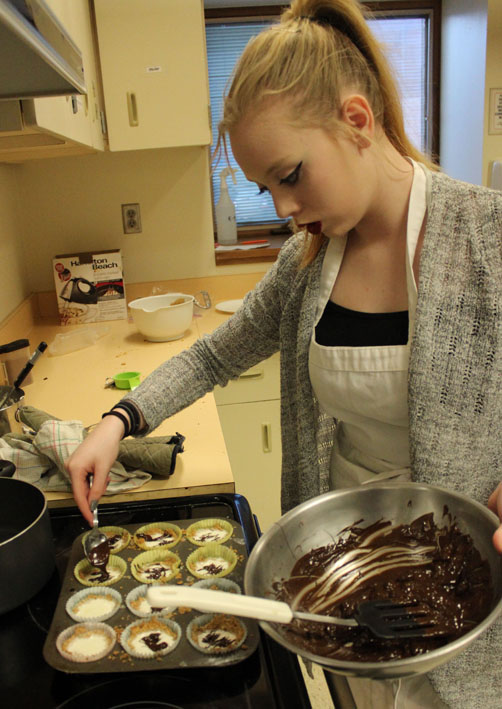Being “chopped” sounds frightening. So does taking a final.
Put the two together, it became an opportunity for Homer High School students in Lauren Childers’ culinary arts class to demonstrate their cooking know-how. For the judges — HHS teacher Paul Story; Rep. Paul Seaton, R-Homer; and yours truly — it was a mouth-watering, stomach-satisfying experience. For Childers, it proved “things we went over so long ago they still remember. They really stepped up their game for the final. I was so impressed.”
Childers designed the final around “Chopped,” a cooking competition show on the Food network that tests speed, skill and ingenuity. Days before the final, she gave the students the ingredients she required them to include in the three-round challenge. They then created recipes including those ingredients and submitted their shopping list to Childers.
Round 1, appetizers, had to include wonton wrappers, pomegranate seeds and edamame. Round two, an entrée, had to include chicken, bread and lemon. Round three, dessert, had to incorporate almond chocolate, marshmallows and graham crackers.
Arriving in the five-kitchen classroom on the afternoon of Dec. 18, the students formed the groups they’ve been cooking with all semester, teamwork being important to the experience.
“That’s definitely an aspect I really hit hard at the beginning of class because I knew it was so critical for success in cooking,” said Childers, who began working professionally in kitchens when she was 16.
The culinary arts class is considered an elective or a “practical arts credit.” This semester it included a mix of boys and girls, freshmen, sophomores, juniors and seniors. The class met four days a week, two days for 55 minutes and two days for 75 minutes. Some began the class knowing their way around a kitchen, others didn’t.
“They all needed practice with basic knife skills … and recipe reading has been a struggle all semester,” said Childers.
The basic curriculum required students learn safe food handling, nutrition and label reading, measurement techniques, recipe terms, functions of ingredients, cookware identification, time management and working in a team environment. Childers created the assignments and recipes to satisfy the requirements.
“My goals for the class were for the students to be able to read any recipe and have the confidence to cook food for themselves,” said Childers. “Cooking for yourself is such an important life skill that can lead to a healthier lifestyle than relying on packaged and processed foods.”
For the final, following the “Chopped” format, the rounds were timed: 20 minutes for appetizers, 30 minutes for the entrée and 30 minutes for the dessert. After each round, the judges evaluated the finished servings on taste, presentation and the students’ ability to incorporate all the required ingredients.
One kitchen was eliminated each round, but that didn’t mean failing the final. It simply meant each student in that kitchen had to complete a “reflections” assignment that asked about successes and failures during the final, what had been learned in the class, the impact the class had beyond the classroom and how the class could be improved.
For each round, Childers announced when timing began. Stoves and ovens were turned on, trips were hurridly made to a table and refrigerator where all the ingredients sat at the ready. Questions directed to Childers were left unanswered. After all, it was a final. As the first round neared completion and it was clear items were not ready, Childers said, “I’m feeling generous. You have two additional minutes.”
Each round clearly refleted the students’ ability to work together and cook creatively. There were wontons wrapped around an edamame stuffing and fried and wontons baked in cupcake pans and filled with cream cheese and smoked salmon. There were alcohol-free marguerita-like drinks made with pomegranates. The entrée round resulted in servings of chicken fingers paired with French toast and a topping of lemon sauce. There were chicken sandwiches with cole slaw on the side. There was fried chicken and salad. Dessert preparations filled the room with the scent of chocolate, as the teams created treats with marshmallow and chocolate sauces.
The winning kitchen was No. 5, Hoxie Parks, Andie Sonnen and Hanna Marsh. The kitchens eliminated in the first and second rounds weren’t for presentation or use of ingredients, but for safety concerns such as chicken being prepared on the same cutting board as vegetables. The most often repeated complaint from the judges was that there was only time to sample, not completely finish, each serving.
Perhaps the greatest compliment came from teachers and students outside the classroom. By the time preparing the dessert round was underway, a sizable crowd was pushing through the doorway, eagerly volunteering to help.
“It’s one of those things that just happens with that class,” said Childers of “kids that come in with ‘what are you cooking today?’” and teachers drawn by tempting aromas.
“I get emails all the time or people come by sixth period, after the class, and ask if there’s anything left over,” said Childers.
Sixteen students are signed up to take the class when it begins again in January. One of this semester’s students, Ciara Cordes-Walker, will return as an aide.
Of this semester’s culinary graduates, Childers said, “I am so proud of them and really sad to see them move on and hope they keep some of the skills they learned.”
McKibben Jackinsky can be reached at mckibben.jackinsky@homernews.com.


